Name the layers in an OSI Network Model
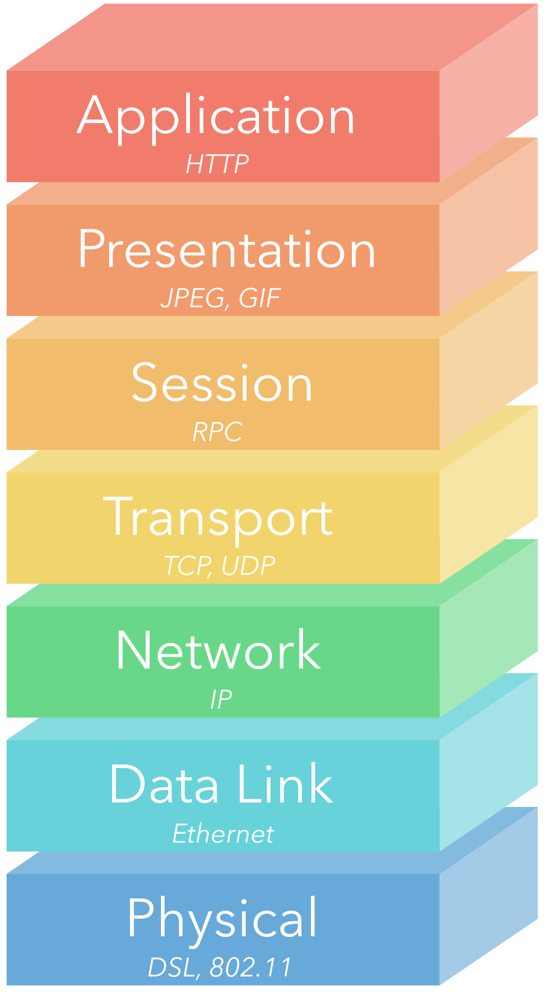
Name the layers in an OSI Network Model

Name the layers in a TCP/IP Network Model
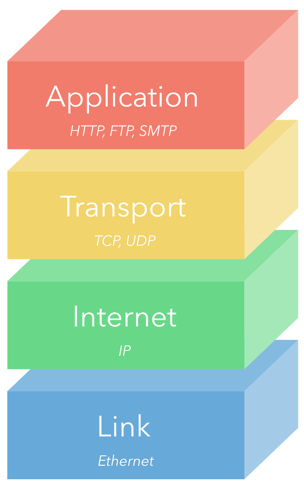
In the OSI Network Model, briefly describe what protocol each layer uses.
| Layer | Protocol and description |
|---|---|
| Application | HTTP is a common Application Layer protocol. Data transmitted on this layer will interact directly with applications. |
| Presentation | JPEG, GIF are examples of protocols at this layer. This is where the data gets translated into a presentable format. |
| Session | RPC (Remote Procedure Call): Includes protocols responsible for authentication and data continuity. May authroize a client with a server or re-establish a dropped connection. |
| Transport | TCP/UDP: These processes focus on data integrity and connectivity |
| Network | IP: Manages connections between remote networks, transferring packets across intermediary devices. |
| Data Link | Ethernet : Deals with connections directly from one machine's network interface to another. Frames targeting different MAC addresses are transferred here. This layer is primarily used by machines in local networks. |
| Physical | Wi-Fi (802.11) and DSL : Translate from raw electrical signals to bits and bytes of data. |
In the TCP/IP model, briefly describe the 4 layers
| Layer | Protocols and application |
|---|---|
| Application | HTTP, HTTPS, FTP, SMTP, etc. Includes protocols related to user user-facing data. |
| Transport | TCP and UDP. Focuses on connectivity between clients and servers. |
| Internet | IP. Where data is processed in packets, and where routing is handled with IP addresses. This layer focuses primarly on connecting separate networks together using the Internet Protocol (IP). |
| Link | Ethernet. This layer is the lower-level communication, concerned with getting data from one local network resource to another. |
What are some use cases for TCP protocol?
Anytime data integrity is important:
What are some use cases for the UDP protocol?
When performance is more important than quality:
What is a TLD?
Top level domain: The last part of the domain. e.g.: .com, .net, .org
What is a second-level domain
What does TCP stand for?
Transmission Control Protocol : Used when you want reliable connections such as web browsing, downloading files, fetching email, streaming music or videos.
What does UDP stand for:
User Datagram Protocol: Used when you don't mind a more unreliable connection, but real time interactivity is more important. Voice Over IP, Video Chat are examples of where you might use UDP
What is a MAC Address?
A hardware address assigned to every physical networking device on a network. They look like a series of Hexidecimal values like ea:de:36:d9:5a:b8; They are used to communicate on the local network ONLY.
Describe an IP address
An address assigned to a networking device. Usually assigned by an ISP or a router on a local network using DHCP. They are used to route connections across multiple networks. Example: IPV4: 192.168.1.1
Describe a Port
Represents a TCP/UDP connection on an actual computer. Valid ports are in the range from 0 - 65535. Used by the operating system of a computer to route TCP connections to the right program running on a computer. These programs can be said to be "listening" on a port. No two programs are allowed to listen on the same port at once.
What are the default ports for web servers?
HTTP port 80, and HTTPS port 443.
What is a Network Hub?
A device which hooks multiple computers together over ethernet and blindly repeats ethernet packets to all the other devices on a local area network.
What is a network switch?
A device which intelligently hooks multiple computers together over ethernet and sends ethernet packets to the correct devices on a local area network based on MAC addresses.
What is a router?
A device which is responsible for routing IP packets BETWEEN Different networks.
What is an IP Address
The internet protocol address assigned to a particular networking device
What is a domain name?
A human readable name assigned to an IP address. Examples: google.com or appacademy.io.
What is DNS?
Domain Name System: A protocol (on UDP port 53) that allows our computer to talk to a DNS Server and resolve a Domain Name into an IP address. Example: google.com might resolve to 172.217.6.142.
What is a DNS A Record?
This record directly maps a domain name to an IPv4 Address
What is a DNS AAAA record?
This directly maps a domain name to an IPv6 Address
What is a CNAME record?
This maps a domain name to another domain name. An alias, you might say.
What is an MX record?
This defines the mail server for a domain.
What is an NS record?
This defines the DNS Servers for a zone (domain)
What is an SOA?
Start of Authority: Defines which DNS Server is the authority for a zone (domain)
In the IP packet header, where do you discover whether this is an IPv4 or IPv6 packet?
In the version. This is a binary number. IPv4 = 0100; IPv6 = 0110. The version number is the 1st->4th bit in the packet
How many octets make up an IPv4 address?
4 octets: 192.168.1.1 for example
How is an IPv6 number made up?
Describe the rules for reformatting an IPv6 address
Describe an IPv6 header
The IPv6 header
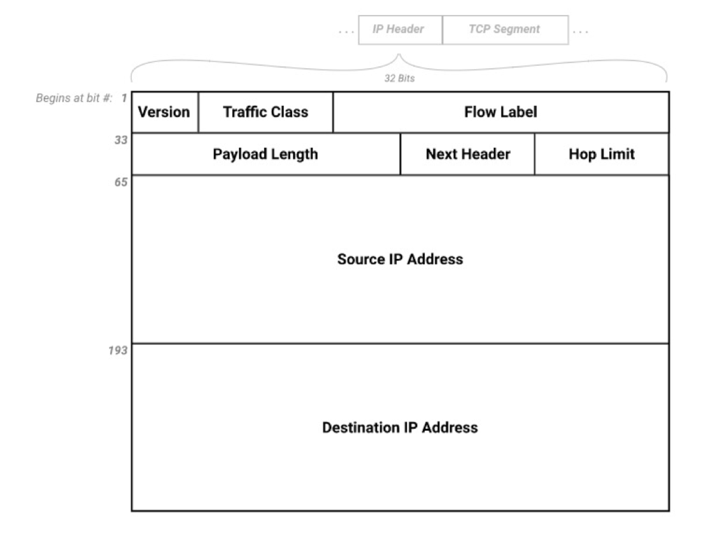
Which version is this IP header?
IPv4 : Identified by the first 4 bits on the header, 0100 = 4. Also, this header has many additional fields included in it. IHL, DSCP, ECN, Total Length, Identification, Flags, Fragment Offset, Time To Live, Protocol, Header Checksum and Options. Notice the 3 fields that are the same between IPv4 and IPv6 headers: Version, Source IP Address and Destination IP Address
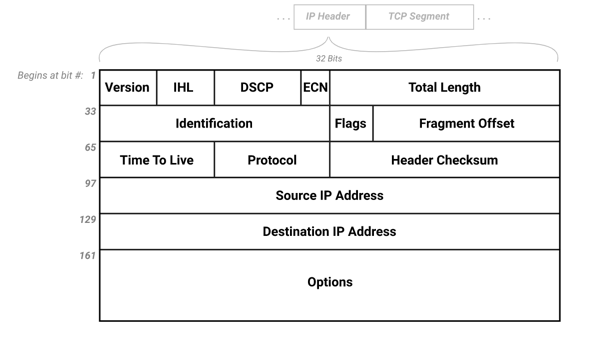
Identify which IP version this header is:
IPv6: Notice many fewer fields (8 vs 14), but has Version, Source IP Address and Destination IP Address in common

Which TCP/IP Layer does the IP Header reside?
The Internet Layer (IP)
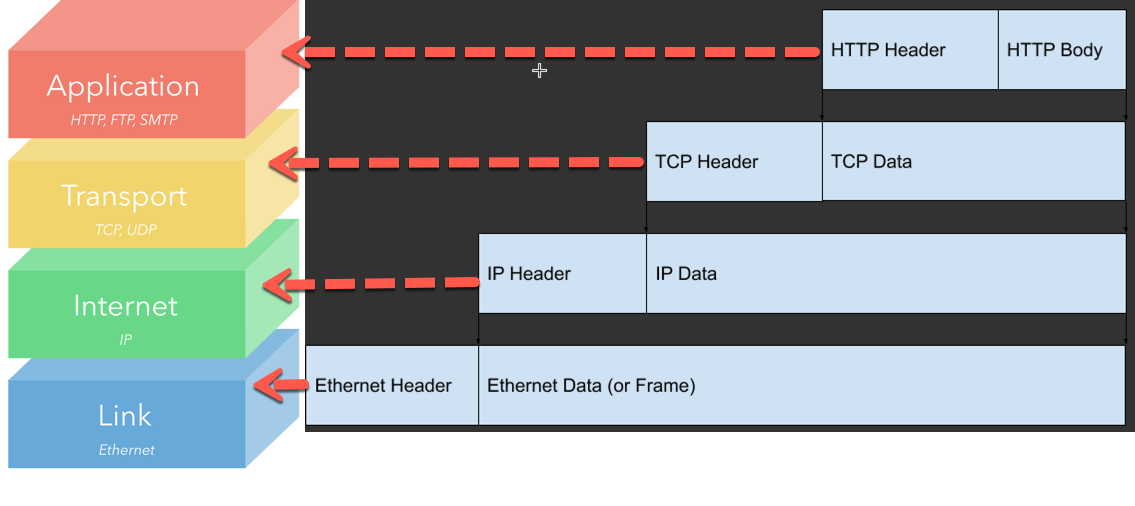
In the OSI Model, which layer do Hubs, Switches and Routers exist at?
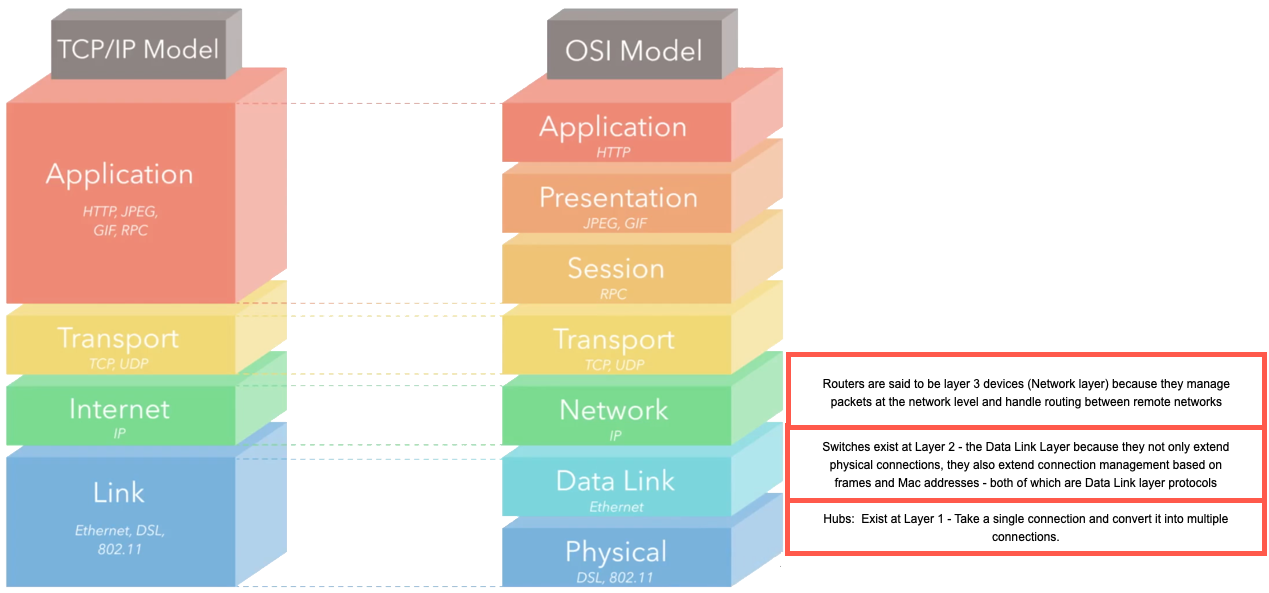
Is a linked list a graph?
Yes!

What is a Tree?
A tree is a graph that does not contain any cycles. Note the image below. Tree 4 is a graph in mathematics,
but in computer science it is not.

Define a binary tree
A binary tree is a tree where nodes have at most 2 children. Graphs 1, 2 and 3 are all binary trees shown
below.

Define the three binary tree depth-first searches (traversing the tree)
Determine the nodes to be searched in pre-order traversal, in the following graph:
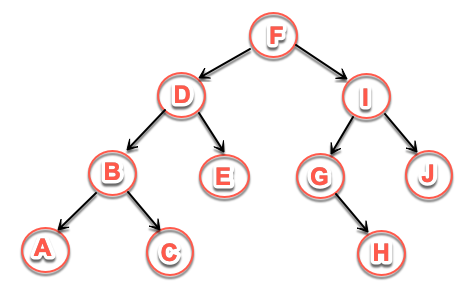
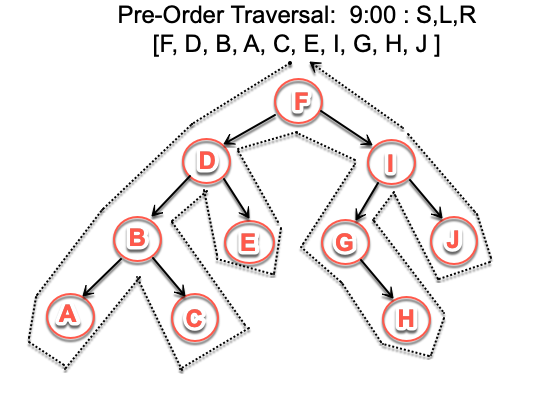
Determine the nodes to be searched in in-order traversal, in the following graph:

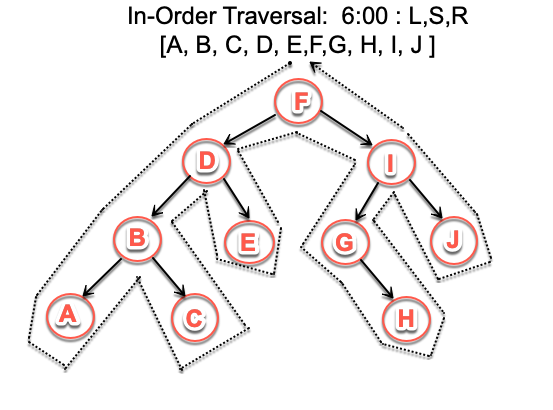
Determine the nodes to be searched in post-order traversal in the following graph:

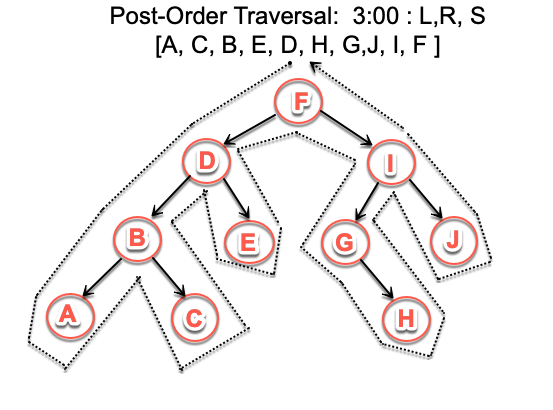
Write a recursive function to print a binary search tree inOrder
function inOrderPrint(root) {
if (!root) return;
inOrderPrint(root.left);
console.log(root.val);
inOrderPrint(root.right);
}
Write a recursive function to print a binary search tree in PostOrder
function postOrderPrint(root) {
if (!root) return;
postOrderPrint(root.left);
postOrderPrint(root.right);
console.log(root.val)
}
Write a recursive function to print a binary search tree in PreOrder
function inPreOrder(root) {
if (!root) return;
console.log(root.val);
inPreOrder(root.left);
inPreOrder(root.right);
}
Write a recursive function to perform a breadth-first search.
function printBreadthFirst(root) {
let queue = [];
queue.push(root);
while (queue.length) {
let currNode = queue.shift();
if (currNode.left) queue.push(currNode.left);
if (currNode.right) queue.push(currNode.right);
console.log(currNode.val);
}
}
Write a recursive function that returns an array in postOrder.
function postOrderArray(root) {
if (!root) return [];
return [
...postOrderArray(root.left),
...postOrderArray(root.right),
root.val
]
}
Write a function that returns an array in pre-order order.
function preOrderArray(root) {
if (!root) return [];
return [
root.val,
...preOrderArray[root.left],
...preOrderArray[root.right]
]
}
Write a function that returns an array inOrder order.
function inOrderArray(root){
if (!root) return [];
return [
...inOrderArray(root.left),
root.val,
...inOrderArray(root.right)
]
}
Write a function that adds a node to a binary search tree
function add(root, val) {
if (!root) //root is null
{
let newNode = new Node(val);
root = newNode;
}
if (val < root.val) {
if (root.left === null) {
let newNode = new Node(val);
root.left = newNode;
} else {
add(root.left, val);
}
else if (val > root.val) {
if (root.right === null) {
let newNode = new Node(val);
root.right = newNode;
} else {
add(root.right, val);
}
}
Write a function to search a binary search tree recursively for a value. If the value is found, return true. Otherwise return false.
function searchRecurse(root, val) {
if (!root) return false;
if(root.val < val) {
return searchRecurse(root.right, val);
} else if (root.val > val) {
return searchRecurse(root.left, val);
} else // (root.val === val) {
return true;
}
}
Write an iterative search for a binary tree, returning true or false if the value is found.
function searchIter(root, val) {
let currNode = root;
while (currNode) {
if (currNode.val < val) {
currNode = currNode.right;
} else if (currNode.val > val) {
currNode = currNode.left;
} else if (currNode.val === val) {
return true;
}
}
return false;
}
What are the two properties that make a Binary Tree a Binary Search Tree
Define a graph
A graph is a collection of nodes and any edges between those nodes.
Are linked lists a subclass of a graph?
Yes!
Are trees a subclass of graphs?
Yes!
Are binary search trees a subclass of graphs?
Yes!
Name two ways we can create a graph
Write a breadthFirstSearch for a graph, iteratively.
let graph = {
'q': ['r'],
'r': ['q'],
's': ['t'],
't': ['s', 'u', 'v'],
'u': ['t', 'v'],
'v': ['u', 't'],
'w': []
};
function breadthFirstSearch(graph, startingNode, targetVal) {
let queue = [ startingNode ];
let visited = new Set();
while(queue.length) {
let node = queue.shift();
if (visited.has(node)) continue;
visited.add(node);
if (node === targetVal) return true;
queue.push(...graph[node]);
}
return false;
}
breadthFirstSearch(graph, graph['t'], 'q'); //returns true;
breadthFirstSearch(graph, graph['q'], 'c'); //returns false;
Write a depth-first Search on the adjacency list graph.
Note with the following: If your graph has disjointed subgraphs - in that there is no way to move from one
subgraph to another, your starting node is ONLY the subgraph you want to search through. Also note, this
algorithm only works on graphs with NO cycles. We won't be tested on searching through a cycle for
depth-first, so set that topic aside. Also note, mathematicians consider cycles as a graph. Computer
scientists do not.
const depthFirst = (graph, node, targetVal, visited = new Set()) => {
if (node === targetVal) return true;
visited.add(node);
for (let neighbor of graph[node]) {
if (visited.has(neighbor)) continue;
if (depthFirst(graph, neighbor, targetVal, visited)) {
return true;
}
}
return false;
};
Name the steps for whiteboarding.